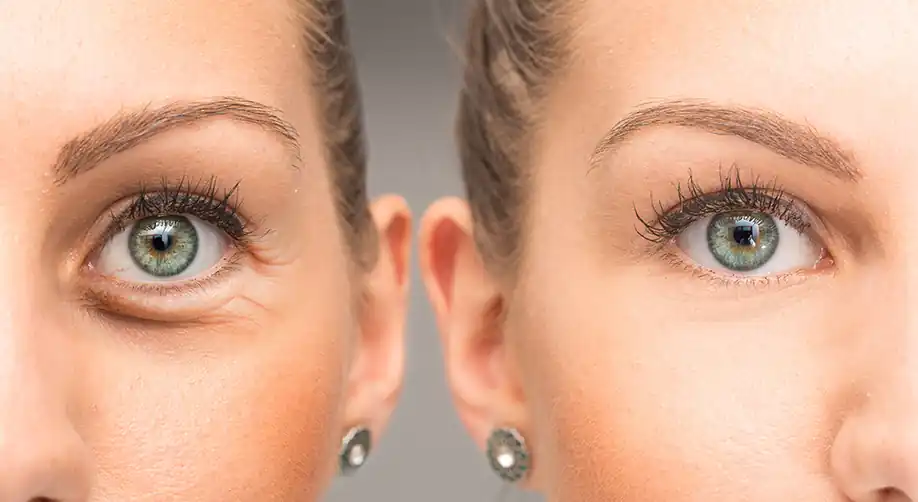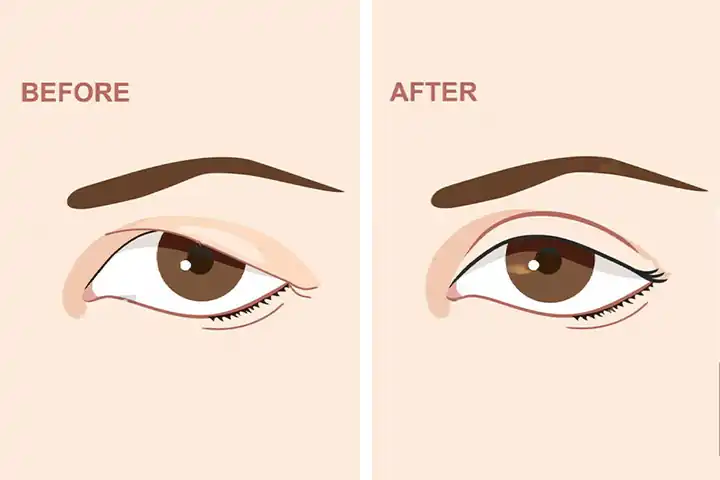Oculoplasty
Oculoplasty is the art and science of plastic surgery around the eye. The eyeball is a delicate structure, protected from harm by eyelids in front and the bony cup (socket) behind. Behind the eyeball run the nerves , arteries and muscles, which carry messages to the brain, move the eyeball, and provide nutrition to the eye. Oculoplasty deals with all these structures surrounding the eyeball.

Why Should an Eye Surgen do Plastic Surgery?
Oculoplastic surgeons first train as ophthalmologists, when they learn in details about the eye. During further higher training, they start to handle plastic surgery. They have the best knowledge about the eye and its surrounding; as eye surgeons, they are also ready to handle the most delicate of structures. This combination of skills makes the oculoplastic surgeons the best to do plastic surgery around the eye.
Eyelid
- Ptosis: Ptosis is drooping of the upper lid. It may be present by birth, or appear later in life. Ptosis is usually corrected by surgery.
- Entropion: Entropion is in-turning of the eyelid. The eyelashes rub on the eye and cause pain and watering; treatment is by surgery.
- Ectropion: Ectropion is turning outwards of the eyelid margin, causing redness and watering (Link to gallery)Lagophthalmos- where the patient cannot close his eye; this can cause danger to the eye, pain and infection.
Orbit
- Orbital fractures: A fracture in the bones around the eye can cause double vision, and a sunken small appearance of the eye. The fracture is repaired with an implant or plate. The best results are obtained in surgery within 2 weeks of injury, but surgery can also be done later.
Socket
- Enucleation/ evisceration: A highly damaged eye may be replacedwith an orbital implant; this restores the comfort and appearance.
- Socket reconstruction: where the eye has been removed for a serious disease, the socket of the eye may get shrunken. The socket is reconstructed to improve comfort and appearance.
- Customised prosthesis
- Lacrimal(eye watering) DCR, probing, intubations.
Aesthetic
- Blepharoplasty: Correction of eyelid bags
- Scar modification
- Ptosis
- Eyelid retraction
- Wrinkle treatment
Special Clinics
- Thyroid eye disease: Thyroid disease can have a serious effect on the eye. The eye develops a bulging look; the patient can have itching and burning, discomfort, corneal ulcers, double vision, and even loss of vision.
Our thyroid eye disease clinic monitors the eye health regularly, so that any danger to the eye is prevented. By injection and surgery, the changes done by the disease can be reversed back to normal. (Add on link to information sheet for thyroid patients).
- Botox clinic: hemifacial spasm, essential blepharospasm, wrinkle treatment. Due to over-action of muscles around the eye, the eyes can go into spasm – where the face and eyes twitch; patient is not able to open the eyes comfortably. This can be treated safely and effectively by injection of botulinum toxin.
- Trauma: Eyelid tear repairs (link to lid tear repairs under eyelid), orbital fracture (link to orbital fractures under orbit)
- Ocularistry: When an eye has been removed due to disease, it may have a serious impact on the psychological and social well-being of the patient. Ocularistry is the art and science of manufacturing an artificial eye. For customised prosthesis (tailor-made artificial eye)measurements are taken from the patient’s own eye, and colour match is done. Thus the prosthesis fits well, is very comfortable, and looks similar to the patient’s own eye.
- Pediatric oculoplasty: Probing, Ptosis
Facilities Available
- Modern operating theatre
- Operating microscope
- Radio frequency Surgical Unit
- Diode laser for transcanalicular laser DCR
- Mechanized Microdrill for bone surgery
- Head-mounted focussed light
- Nasal endoscopy
- Vacuum aspirator
- Cryopexy machine
- Ultrasound B scan, UBM
- Grafting of donor sclera, amniotic membrane
- Stitch-less surgery with tissue glue
Ptosis
Ptosis is a drooping or falling of the upper eyelid. The drooping may be worse after being awake longer, when the individual’s muscles are tired. This condition is sometimes called “lazy eye”, but that term normally refers to amblopia. If severe enough and left untreated, the drooping eyelid can cause other conditions, such as amblyopia or astigmatism. This is why it is especially important for this disorder to be treated in children at a young age, before it can interfere with vision development.
Causes
Ptosis occurs due to dysfunction of the muscles that raise the eyelid or their nerve supply (oculomotor nerve for levator palpebrae superioris and sympathetic nerves for superior tarsal muscle). It can affect one eye or both eyes and is more common in the elderly, as muscles in the eyelids may begin to deteriorate. One can, however, be born with ptosis. Congenital ptosis is hereditary in three main forms.[1] Causes of congenital ptosis remain unknown. Ptosis may be caused by damage/trauma to the muscle which raises the eyelid, damage to the superior cervical sympathetic ganglion or damage to the nerve (3rd cranial nerve (oculomotor nerve)) which controls this muscle. Such damage could be a sign or symptom of an underlying disease such as diabetes mellitus, a brain tumor, a pancoast tumor (apex of lung) and diseases which may cause weakness in muscles or nerve damage, such as myasthenia gravis or Oculopharyngeal muscular dystrophy. Exposure to the toxins in some snake venoms, such as that of the black mamba, may also cause this effect.
Ptosis can be caused by the aponeurosis of the levator muscle, nerve abnormalities, trauma, inflammation or lesions of the lid or orbit.[2] Dysfunctions of the levators may occur as a result of autoimmune antibodies attacking and eliminating the neurotransmitter
Ptosis may be due to a myogenic, neurogenic, aponeurotic, mechanical or traumatic cause and it usually occurs isolated, but may be associated with various other conditions, like immunological, degenerative, or hereditary disorders, tumors, or infections
Acquired ptosis is most commonly caused by aponeurotic ptosis. This can occur as a result of senescence, dehiscence or disinsertion of the levator aponeurosis. Moreover, chronic inflammation or intraocular surgery can lead to the same effect. Also, wearing contact lenses for long periods of time is thought to have a certain impact on the development of this condition.
Congenital neurogenic ptosis is believed to be caused by the Horner syndrome.In this case, a mild ptosis may be associated with ipsilateral ptosis, iris and areola hypopigmentation and anhidrosis due to the paresis of theMueller muscle. Acquired Horner syndrome may result after trauma, neoplastic insult, or even vascular disease.
Ptosis due to trauma can ensue after an eyelid laceration with transection of the upper eyelid elevators or disruption of the neural input.
Other causes of ptosis include eyelid neoplasms, neurofibromas or the cicatrization after inflammation or surgery. Mild ptosis may occur with aging. A drooping eyelid can be one of the first signals of a third nerve palsy due to a cerebral aneurysm, that otherwise is asymptomatic and referred to as an oculomotor nerve palsy.

